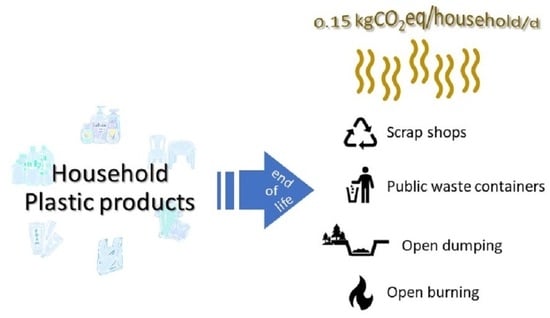CO2 Emissions from Plastic Consumption Behaviors in Thailand
Abstract
1. Introduction
2. Methodology
2.1. Questionnaire Design
2.2. Sample Size
2.3. Data Analysis
2.4. Greenhouse Gas Emissions Analysis
3. Results and Discussion
3.1. Plastic Consumption Behaviors
3.2. Multiple Linear Regression Analysis
3.3. Greenhouse Gas (GHG) Emissions
4. Conclusions
Author Contributions
Funding
Institutional Review Board Statement
Informed Consent Statement
Data Availability Statement
Acknowledgments
Conflicts of Interest
References
- PlasticsEurope. Plastic—The Fact 2022; Plastics Europe AISBL: Bruxelles, Belgium, 2022. [Google Scholar]
- Thompson, R.C.; Moore, C.J.; Saal, F.S.V.; Swan, S.H. Plastics, the environment and human health: Current consensus and future trends. Philos. Trans. R. Soc. Lond. B Biol. Sci. 2009, 364, 2153–2166. [Google Scholar] [PubMed]
- E-Statistic: TSIC (The Office of Industrial Economics). Available online: https://indexes.oie.go.th/industrialStatistics1.aspx (accessed on 30 May 2023).
- Neo, E.R.K.; Soo, G.C.Y.; Tan, E.Z.L.; Cady, K.; Tong, K.T.; Low, J.S.C. Life cycle assessment of plastic waste end-of-life for India and Indonesia. Resour. Conserv. Recycl. 2021, 174, 105774. [Google Scholar]
- Wang, W.; Themelis, N.J.; Sun, K.; Bourtsalas, A.C.; Huang, Q.; Zhang, Y.; Wu, Z. Current influence of China’s ban on plastic waste imports. Waste Dispos. Sustain. Energy 2019, 1, 67–78. [Google Scholar]
- University of Michigan. Plastic Waste Factsheet; Pub. No. CSS22-11; University of Michigan: Ann Arbor, MI, USA, 2022. [Google Scholar]
- Country Profile Thailand (SEA Circular). Available online: https://www.sea-circular.org/wp-content/uploads/2020/04/SEA-circular-Country-Briefing_THAILAND.pdf (accessed on 30 May 2023).
- Heller, M.C.; Mazor, M.H.; Keoleian, G.A. Plastics in the US: Toward a material flow characteristic of production, markets and end of life. Environ. Res. Lett. 2020, 15, 094034. [Google Scholar]
- Plastic Pollution Is Growing Relentlessly as Waste Management and Recycling Fall Short (OECD). Available online: https://www.oecd.org/environment/plastic-pollution-is-growing-relentlessly-as-waste-management-and-recycling-fall-short.htm (accessed on 22 February 2022).
- Pollution Control Department. Thailand’s Roadmap on Plastic Waste Management 2018–2030; Ministry of Natural Resources and Environment: Bangkok, Thailand, 2018.
- UNEP. Turning off the Tap: How the World Can End Plastic Pollution and Create a Circular Economy; UNEP Communication Division: Nairobi, Kenya, 2023; ISBN 978-92-807-4024-0. [Google Scholar]
- Tenhunen-Lunkka, A.; Rommens, T.; Vanderreydt, I.; Mortensen, L. Greenhouse Gas Emission Reduction Potential of European Union’s Circularity Related Targets for Plastics. Circ. Econ. Sust. 2023, 3, 475–510. [Google Scholar] [CrossRef]
- Wichai-utcha, N.; Chavalparit, O. 3Rs Policy and plastic waste management in Thailand. J. Mater. Cycles Waste Manag. 2019, 21, 10–22. [Google Scholar]
- Ministry of Natural Resources and Environment. Mid-Century, Long-Term Low Greenhouse Gas Emission Development Strategy; Paris Agreement: Thailand; Ministry of Natural Resources and Environment: Bangkok, Thailand, 2021.
- Smith, S.M.; Lowe, J.A.; Bowerman, N.H.A.; Gohar, L.K.; Huntingford, C.; Allen, M.R. Equivalence of greenhouse-gas emissions for peak temperature limits. Nat. Clim. Chang. 2012, 2, 535–538. [Google Scholar]
- Meinshausen, M.; Meinshausen, N.; Hare, W.; Raper, S.C.B.; Frieler, K.; Knutti, R.; Frame, D.J.; Allen, M.R. Greenhouse-gas emission targets for limiting global warming to 2 °C. Nature 2009, 458, 1158–1163. [Google Scholar] [CrossRef]
- OECD. Climate Change and Plastics Pollution; OECD Policy Highlights; OECD: Paris, France, 2023.
- What Do Plastic Have To Do with Climate Change? Available online: https://stories.undp.org/what-do-plastics-have-to-do-with-climate-change (accessed on 30 November 2022).
- Hoegh-Guldberg, O.; Jacob, D.; Taylor, M.A.; Bindi, M.; Brown, S.; Camilloni, I.; Diedhiou, A.; Djalante, R.; Ebi, K.L.; Engelbrecht, F.; et al. Impacts of 1.5 °C Global Warming on Natural and Human Systems. In Global Warming of 1.5 °C. An IPCC Special Report on the Impacts of Global Warming of 1.5 °C above Pre-Industrial Levels and Related Global Greenhouse Gas Emission Pathways; IPCC Secretariat: Geneva, Switzerland, 2018; pp. 175–312. [Google Scholar]
- Teplitsky, C.; Millien, V. Climate warming and Bergmann’s rule through time: Is there any evidence? Evol. Appl. 2013, 7, 156–168. [Google Scholar]
- Cui, H.; Töpper, J.P.; Yang, Y.; Vandvik, V.; Wang, G. Plastic population effects and conservative leaf traits in a reciprocal transplant experiment simulating climate warming in the Himalayas. Front. Plant Sci. 2018, 9, 1069. [Google Scholar]
- JICA. Country Report Thailand: Natural Disaster Risk Assessment and Area Business Continuity Plan Formulation for Industrial Agglomerated Areas in the ASEAN Region; Japan International Cooperation Agency: Tokyo, Japan; OYO International Corp.: Tokyo, Japan; Mitsubishi Research Institute, Inc.: Tokyo, Japan; CTI Engineering International Co., Ltd.: Tokyo, Japan, 2015.
- Jallaludin, N.S.K.; Sukarno, N.S.; Nasir, S.N.B.M.; Isamil, N.A.; Shah, N.A.A.; Sabri, H.N.M.; Mohammad, N. A Systematic Review on Consumer Behavior toward Plastic Consumption in Asian Countries. Adv. Bus. Res. Int. J. 2021, 7, 150–158. [Google Scholar] [CrossRef]
- Khoironi, A.; Anggoro, A.; Sudarno, S. Community behavior and single-use plastic bottle consumption. IOP Conf. Ser. Earth Environ. Sci. 2019, 293, 012002. [Google Scholar] [CrossRef]
- Gu, F.; Zhu, Z.; Ali, S. Analysis of Factors of Single-Use Plastic Avoidance Behavior for Environmental Sustainability in China. Processes 2023, 11, 1412. [Google Scholar] [CrossRef]
- Jesevičiūtė-Ufartienė, L. Differences of consumer behaviour regarding plastic usage. Manag. Theory Stud. Rural. Bus. Infrastruct. Dev. 2019, 41, 520–526. [Google Scholar] [CrossRef]
- Northen, S.L.; Nieminen, L.K.; Cunsolo, S.; Lorfa, S.K.; Roberts, K.P.; Fletcher, S. From shops to bins: A case study of consumer attitudes and behaviours towards plastics in a UK coastal city. Sustain. Sci. 2023, 18, 1379–1395. [Google Scholar] [CrossRef]
- Nguyen, X.C.; Dao, D.C.; Nguyen, T.T.; Tran, Q.B.; Nguyen, T.T.H.; Tuan, T.A.; Nguyen, K.L.P.; Nguyen, N.; Nadda, A.K.; Thanh-Nho, N.; et al. Generation patterns and consumer behavior of single-use plastic towards plastic-free university campuses. Chemosphere 2022, 291, 133059. [Google Scholar] [CrossRef]
- Kautish, P.; Sharma, R.; Mangla, S.K.; Jabeen, F.; Awan, U. Understanding choice behavior towards plastic consumption: An emerging market investigation. Resour. Conserv. Recycl. 2021, 174, 105828. [Google Scholar] [CrossRef]
- Demography Population and Housing Branch (National Statistical Office). Available online: http://statbbi.nso.go.th/staticreport/page/sector/en/01.aspx (accessed on 30 May 2023).
- ISO 14040:2006; Environmental Management—Life Cycle Assessment—Principles and Framework. ISO: Geneva, Switzerland, 2006.
- Greenhouse Gas Protocol. Technical Guidance for Calculating Scope 3 Emissions; World Resources Institute & World Business Council for Sustainable Developmen: Geneva, Switzerland, 2013. [Google Scholar]
- Emission Factor (Greenhouse Gas Management Organization). Available online: http://thaicarbonlabel.tgo.or.th/index.php?lang=TH&mod=YUc5dFpRPT0 (accessed on 30 May 2023).
- Thailand Greenhouse Gas Management Organization. City Carbon Footprint Ebook; Ministry of Natural Resources and Environment: Bangkok, Thailand, 2016.
- Borongan, G.; Kashyap, P. Country Profile Thailand; GIZ: Bonn, Germany, 2018. [Google Scholar]
- Niyommaneerat, W.; Suwanteep, K.; Chavalparit, O. Sustainability indicators to achieve a circular economy: A case study of renewable energy and plastic waste recycling corporate social responsibility (CSR) projects in Thailand. J. Clean. Prod. 2023, 391, 136203. [Google Scholar] [CrossRef]
- OECD. Global Plastics Outlook: Economic Drivers, Environmental Impacts and Policy Options; OECD Publishing: Paris, France, 2022.
- Jeżewska-Zychowicz, M.; Jeznach, M. Consumers’ behaviours related to packaging and their attitudes towards environment. J. Agribus. Rural Dev. 2015, 3, 447–457. [Google Scholar]
- Afroz, R.; Rahman, A.; Masud, M.M.; Akhtar, R. The knowledge, awareness, attitude and motivational analysis of plastic waste and household perspective in Malaysia. Environ. Sci. Pollut. Res. 2017, 24, 2304–2315. [Google Scholar] [CrossRef]
- Madigele, P.K.; Mogomotsi, G.E.J.; Kolobe, M. Consumer willingness to pay for plastic bags levy and willingness to accept eco-friendly alternatives in Botswana. Chin. J. Popul. Resour. Environ. 2017, 15, 255–261. [Google Scholar] [CrossRef]
- Volk, R.; Stallkamp, C.; Steins, J.J.; Yogish, S.P.; Müller, R.C.; Stapf, D.; Schultmann, F. Techno-economic assessment and comparison of different plastic recycling pathways. J. Ind. Ecol. 2021, 25, 1318–1337. [Google Scholar] [CrossRef]
- Paolo, L.D.; Abbate, S.; Celani, E.; Battista, D.D.; Candeloro, G. Carbon Footprint of Single-Use Plastic Items and Their Substitution. Sustainability 2022, 14, 16563. [Google Scholar] [CrossRef]
- Luan, X.; Kou, X.; Cui, X.; Chen, L.; Xue, W.; Liu, W.; Cui, Z. Greenhouse gas emissions associated with plastics in China from 1950 to 2060. Resour. Conserv. Recycl. 2023, 197, 107089. [Google Scholar] [CrossRef]
- Kaur, P.; Agrawal, R.; Pfeffer, F.M.; Williams, R.; Bohidar, H.B. Hydrogels in agriculture: Prospects and challenges. J. Polym. Environ. 2023, 1–18. [Google Scholar] [CrossRef]
- Sharma, N.; Allardyce, B.J.; Rajkhowa, R.; Agrawal, R. Delivery of agrochemicals and nutrients through a biopolymer-based system derived from lignocellulosic rice straw. J. Polym. Environ. 2023, 1–15. [Google Scholar] [CrossRef]
- Anderson, A.; Newell, R. Prospects for carbon capture and storage technologies. Annu. Rev. Environ. Resour. 2004, 29, 109–142. [Google Scholar] [CrossRef]
- Boot-Handford, M.E.; Abanades, J.C.; Anthony, E.J.; Blunt, M.J.; Brandani, S.; Dowell, N.M.; Fernandez, J.R.; Ferrari, M.C.; Gross, R.; Hallett, J.P.; et al. Carbon capture and storage update. Energy Environ. Sci. 2014, 7, 130–189. [Google Scholar] [CrossRef]
- Pires, J.C.M.; Martins, F.G.; Alvim-Ferraz, M.C.M.; Simões, M. Recent developments on carbon capture and storage: An overview. Chem. Eng. Res. Des. 2011, 89, 1446–1460. [Google Scholar] [CrossRef]
- Evans, H.A.; Mullangi, D.; Deng, Z.; Wang, Y.; Peh, S.B.; Wei, F.; Wang, J.; Brown, C.M.; Zhao, D.; Canepa, P.; et al. Aluminum formate, Al(HCOO)3: An earth-abundant, scalable, and highly selective material for CO2 capture. Sci. Adv. 2022, 8, eade1473. [Google Scholar] [CrossRef]
- Zhang, Z.; Deng, Z.; Evans, H.A.; Mullangi, D.; Kang, C.; Peh, S.B.; Wang, Y.; Brown, C.M.; Wang, J.; Canepa, P.; et al. Exclusive recognition of CO2 from hydrocarbons by aluminum formate with hydrogen-confined pore cavities. J. Am. Chem. Soc. 2023, 145, 11643–11649. [Google Scholar] [PubMed]
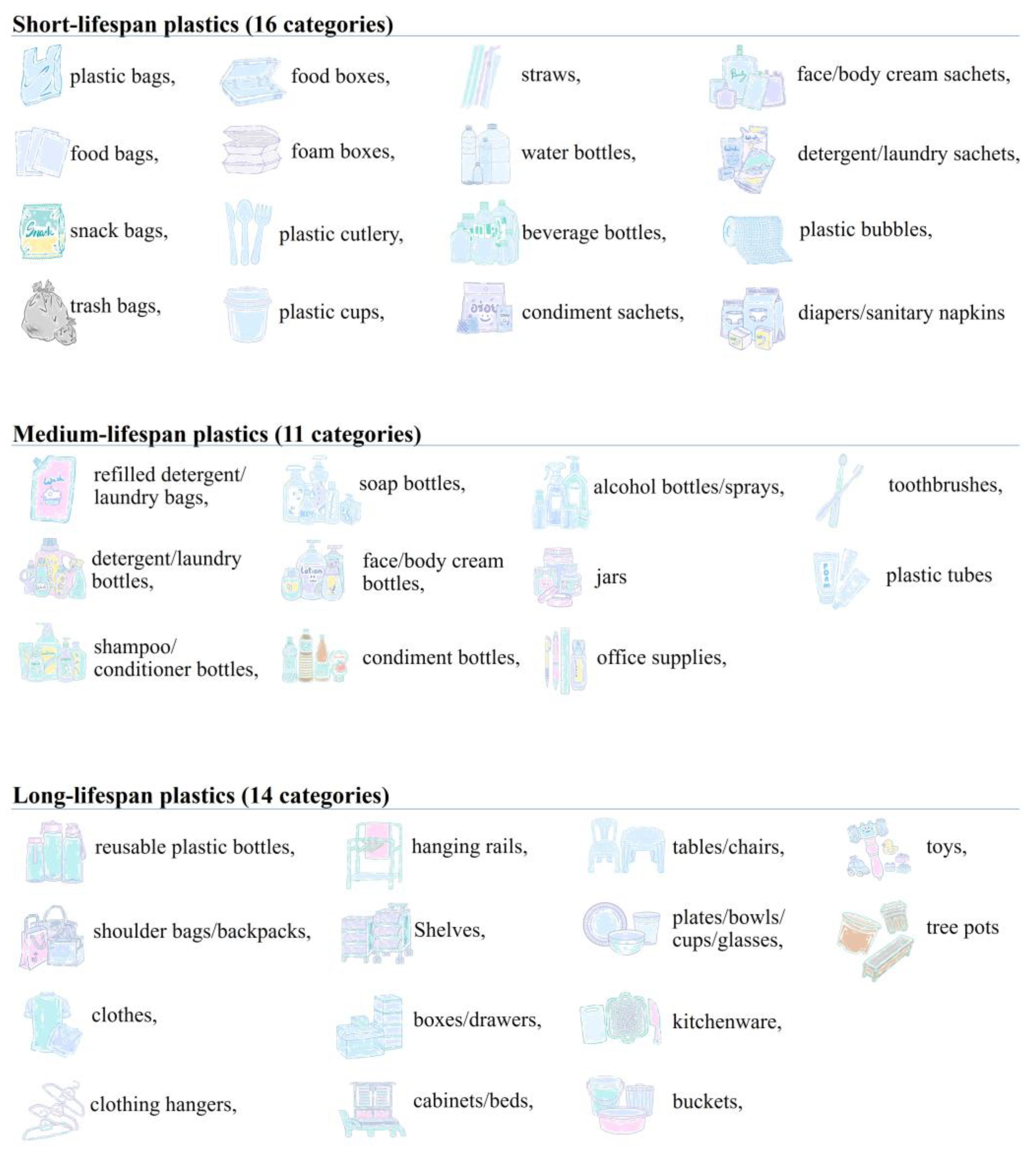
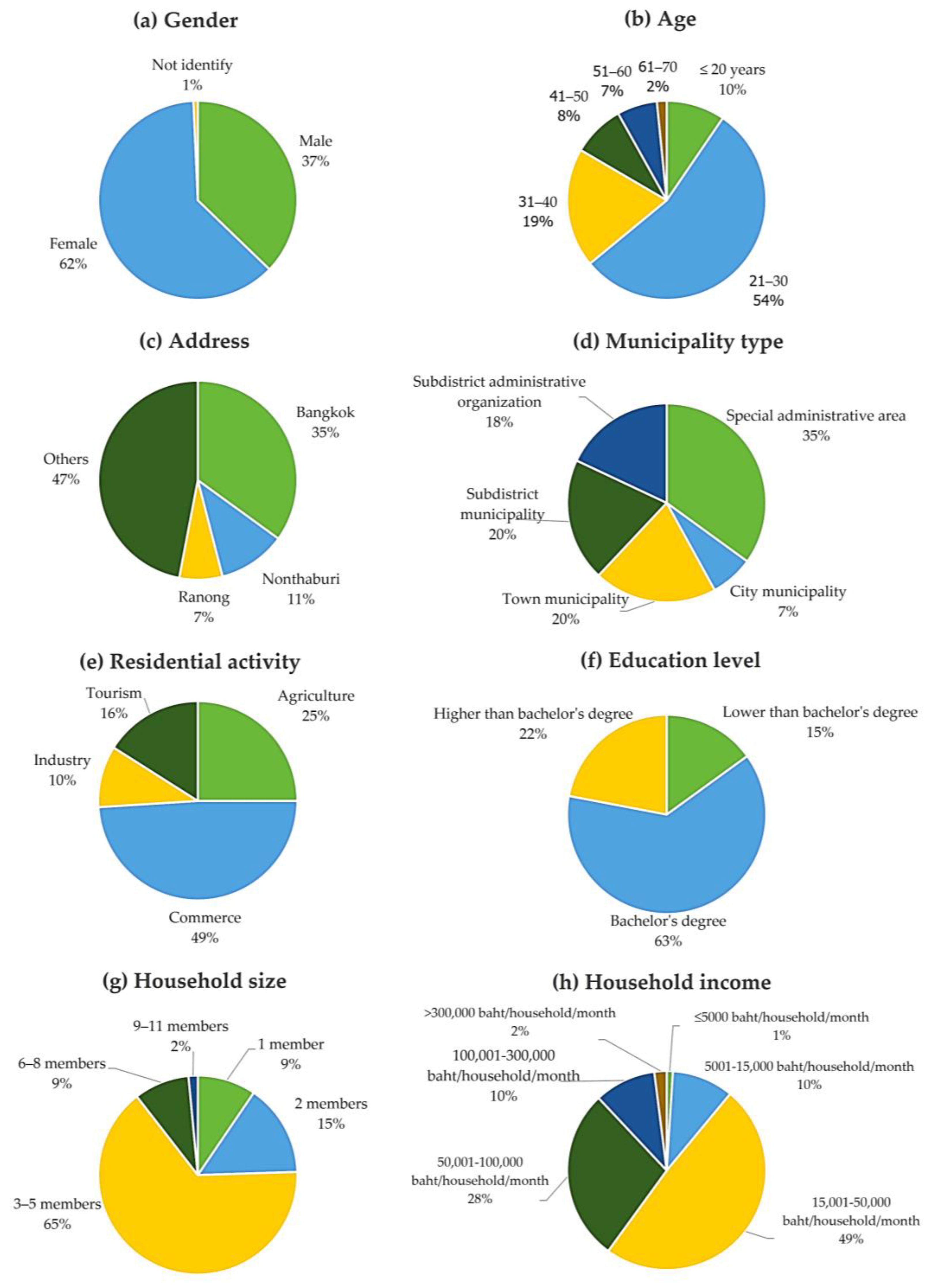

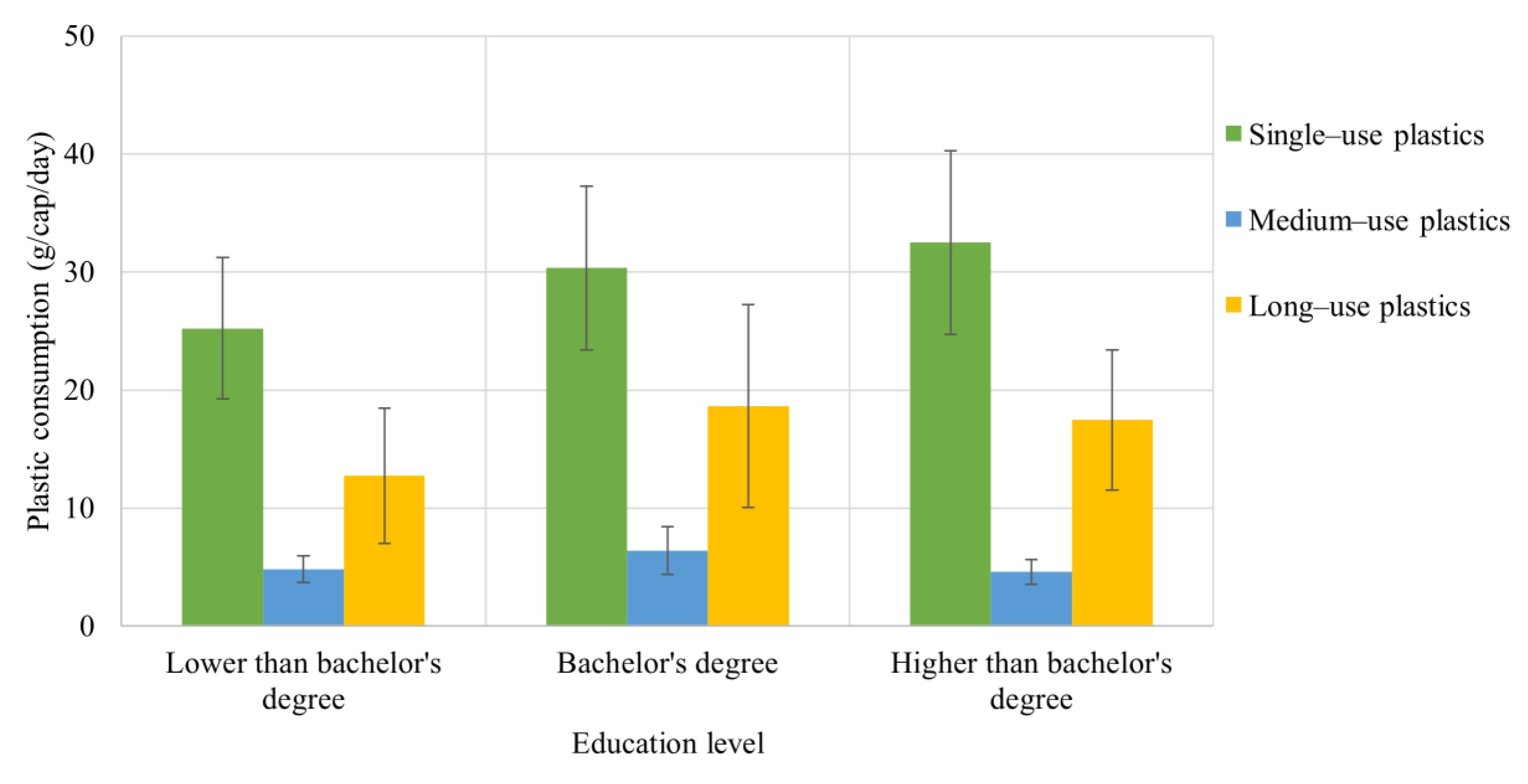
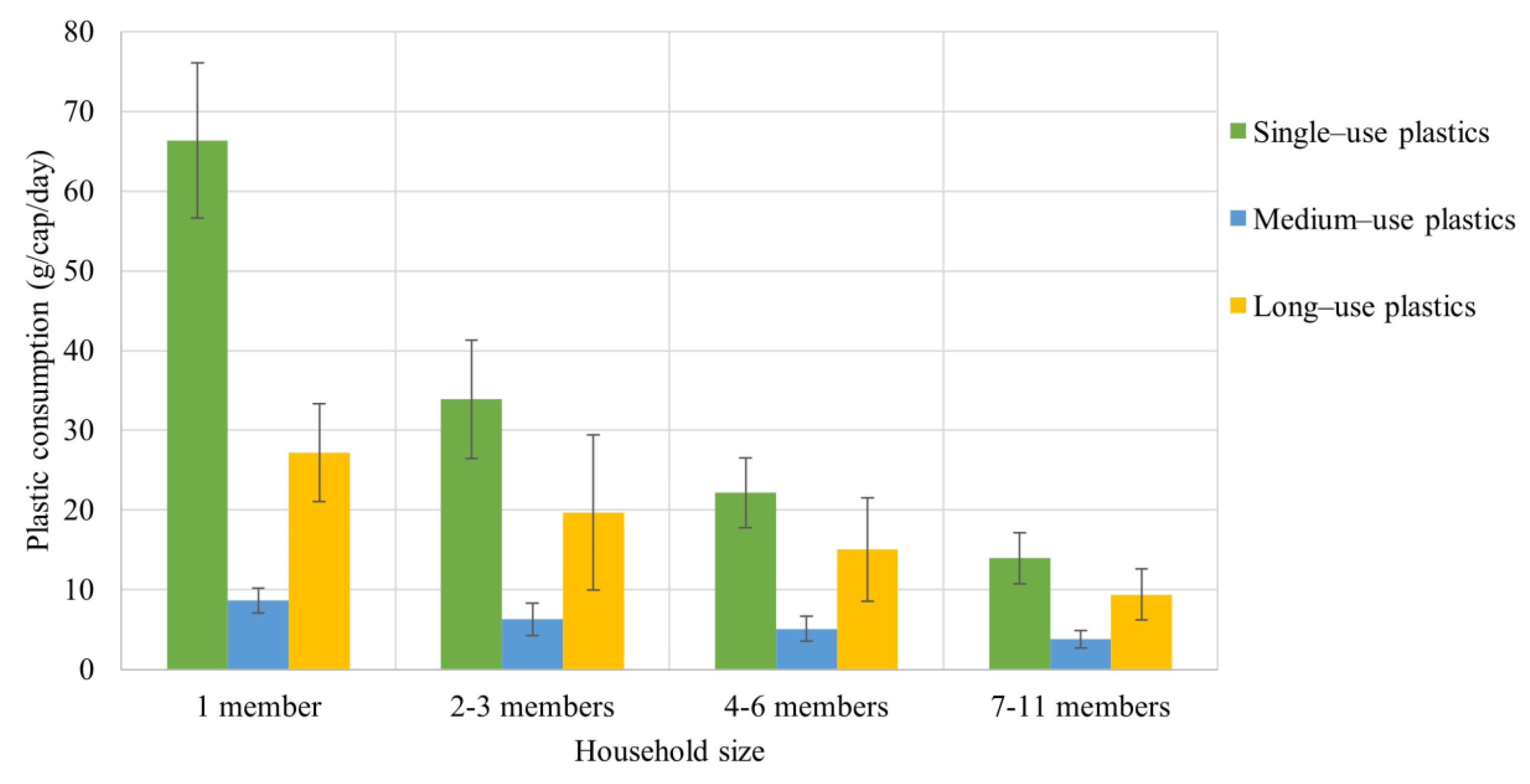
| Municipal Waste Management | Emission Per Unit (kgCO2eq/kg Plastic Product) | Remark |
|---|---|---|
| Disposal to public container | 0.79 | Thailand Greenhouse Gas Management Organization (TGO), 2023 [33] |
| Dumping and covering | 1.04 | Thailand Greenhouse Gas Management Organization (TGO), 2023 [33] |
| Open-burning | 3.54 | Calculation based on TGO guidelines (2016) and GWP AR5 2014 [34] |
| Recycle (sell to junk shop/scrap shop) | 0 | Technical guidance for calculating Scope 3 emissions [32] |
| Category | Average Consumption Rate | |
|---|---|---|
| Piece/Household/Day | Piece/Cap/Day | |
| Plastic bags | 1.16 | 0.38 |
| Food bags | 0.99 | 0.31 |
| Snack bags | 0.65 | 0.21 |
| Trash bags | 0.63 | 0.20 |
| Food boxes | 0.59 | 0.21 |
| Foam boxes | 0.37 | 0.12 |
| Plastic cutlery | 0.38 | 0.13 |
| Plastic cups | 0.55 | 0.20 |
| Straws | 0.75 | 0.25 |
| Water bottles | 1.01 | 0.33 |
| Beverage bottles | 0.66 | 0.21 |
| Condiment sachets | 0.42 | 0.13 |
| Face/body cream sachets | 0.23 | 0.07 |
| Detergent/laundry sachets | 0.31 | 0.09 |
| Plastic bubbles | 0.25 | 0.08 |
| Diapers/sanitary napkins | 0.10 | 0.04 |
| Total | 9.05 | 2.95 |
| Category | Average Consumption Rate | |
|---|---|---|
| Piece/Household/Month | Piece/Cap/Month | |
| Refilled detergent/laundry bags | 1.65 | 0.51 |
| Detergent/laundry bottles | 0.98 | 0.28 |
| Shampoo/conditioner bottles | 1.02 | 0.32 |
| Soap bottles | 0.89 | 0.27 |
| Face/body cream bottles | 0.82 | 0.26 |
| Condiment bottles | 0.98 | 0.28 |
| Alcohol bottles/sprays | 0.69 | 0.21 |
| Jars | 0.71 | 0.22 |
| Office supplies | 0.64 | 0.20 |
| Toothbrushes | 0.83 | 0.26 |
| Plastic tubes | 0.85 | 0.27 |
| Total | 10.07 | 3.09 |
| Category | Average Consumption Rate | |
|---|---|---|
| Piece/Household/Year | Piece/Cap/Year | |
| Reusable plastic bottles | 7.22 | 2.24 |
| Shoulder bags/backpacks | 3.20 | 0.98 |
| Clothes | 5.83 | 1.93 |
| Clothing hangers | 7.87 | 2.54 |
| Hanging rails | 2.37 | 0.69 |
| Shelves | 2.41 | 0.72 |
| Boxes/drawers | 2.57 | 0.80 |
| Cabinets/beds | 1.63 | 0.48 |
| Tables/chairs | 1.85 | 0.57 |
| Plates/bowls/cups/glasses | 3.88 | 1.16 |
| Kitchenware | 2.78 | 0.84 |
| Buckets | 2.78 | 0.87 |
| Toys | 2.80 | 0.89 |
| Tree pots | 2.98 | 0.93 |
| Total | 50.16 | 15.64 |
| Plastic Type | Average Greenhouse Gas Emissions | |
|---|---|---|
| gCO2eq/Household/Day | gCO2eq/Cap/Day | |
| Single-use plastics | 78.54 | 25.14 |
| Medium-use plastics | 16.71 | 4.81 |
| Long-use plastics | 53.96 | 13.73 |
| Total | 149.21 | 43.68 |
Disclaimer/Publisher’s Note: The statements, opinions and data contained in all publications are solely those of the individual author(s) and contributor(s) and not of MDPI and/or the editor(s). MDPI and/or the editor(s) disclaim responsibility for any injury to people or property resulting from any ideas, methods, instructions or products referred to in the content. |
© 2023 by the authors. Licensee MDPI, Basel, Switzerland. This article is an open access article distributed under the terms and conditions of the Creative Commons Attribution (CC BY) license (https://creativecommons.org/licenses/by/4.0/).
Share and Cite
Kittithammavong, V.; Khanitchaidecha, W.; Thongsanit, P. CO2 Emissions from Plastic Consumption Behaviors in Thailand. Sustainability 2023, 15, 12135. https://doi.org/10.3390/su151612135
Kittithammavong V, Khanitchaidecha W, Thongsanit P. CO2 Emissions from Plastic Consumption Behaviors in Thailand. Sustainability. 2023; 15(16):12135. https://doi.org/10.3390/su151612135
Chicago/Turabian StyleKittithammavong, Virin, Wilawan Khanitchaidecha, and Pajaree Thongsanit. 2023. "CO2 Emissions from Plastic Consumption Behaviors in Thailand" Sustainability 15, no. 16: 12135. https://doi.org/10.3390/su151612135
APA StyleKittithammavong, V., Khanitchaidecha, W., & Thongsanit, P. (2023). CO2 Emissions from Plastic Consumption Behaviors in Thailand. Sustainability, 15(16), 12135. https://doi.org/10.3390/su151612135







